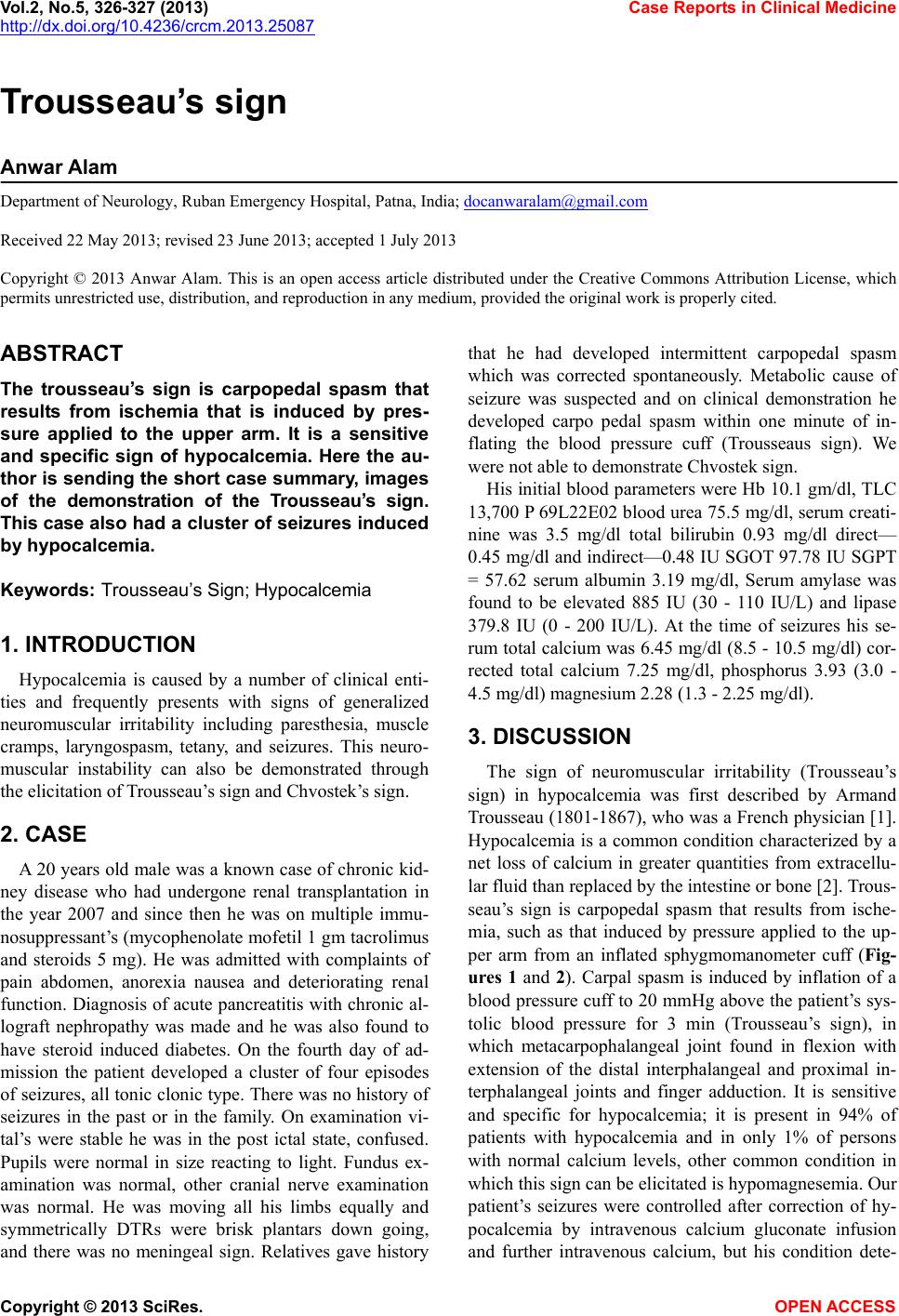
Vol.2, No.5, 326-327 (2013) Case Reports in Clinical Medicine
http://dx.doi.org/10.4236/crcm.2013.25087
Trousseau’s sign
Anwar Alam
Department of Neurology, Ruban Emergency Hospital, Patna, India; docanwaralam@gmail.com
Received 22 May 2013; revised 23 June 2013; accepted 1 July 2013
Copyright © 2013 Anwar Alam. This is an open access article distributed under the Creative Commons Attribution License, which
permits unrestricted use, distribution, and reproduction in any medium, provided the original work is properly cited.
ABSTRACT
The trousseau’s sign is carpopedal spasm that
results from ischemia that is induced by pres-
sure applied to the upper arm. It is a sensitive
and specific sign of hypocalcemia. Here the au-
thor is sending the short case summary, images
of the demonstration of the Trousseau’s sign.
This case als o h ad a cl ust er of s ei zur es induced
by hypocalcemia.
Keyw ords: Trousseau’s Sign; Hypocalcemia
1. INTRODUCTION
Hypocalcemia is caused by a number of clinical enti-
ties and frequently presents with signs of generalized
neuromuscular irritability including paresthesia, muscle
cramps, laryngospasm, tetany, and seizures. This neuro-
muscular instability can also be demonstrated through
the elicitation of Trousseau’s sign and Chvostek’s sign.
2. CASE
A 20 years old male was a known case of chronic kid-
ney disease who had undergone renal transplantation in
the year 2007 and since then he was on multiple immu-
nosuppressant’s (mycophenolate mofetil 1 gm tacrolimus
and steroids 5 mg). He was admitted with complaints of
pain abdomen, anorexia nausea and deteriorating renal
function. Diagnosis of acu te pancreatitis with chron ic al-
lograft nephropathy was made and he was also found to
have steroid induced diabetes. On the fourth day of ad-
mission the patient developed a cluster of four episodes
of seizures, all tonic clonic type. There was no history of
seizures in the past or in the family. On examination vi-
tal’s were stable he was in the post ictal state, confused.
Pupils were normal in size reacting to light. Fundus ex-
amination was normal, other cranial nerve examination
was normal. He was moving all his limbs equally and
symmetrically DTRs were brisk plantars down going,
and there was no meningeal sign. Relatives gave history
that he had developed intermittent carpopedal spasm
which was corrected spontaneously. Metabolic cause of
seizure was suspected and on clinical demonstration he
developed carpo pedal spasm within one minute of in-
flating the blood pressure cuff (Trousseaus sign). We
were not able to demonstrate Chvostek sign .
His initial blood parameters were Hb 10.1 gm/dl, TLC
13,700 P 69L22E02 blood urea 75.5 mg/dl, seru m creati-
nine was 3.5 mg/dl total bilirubin 0.93 mg/dl direct—
0.45 mg/dl and indirect—0.48 IU SGO T 97.78 IU SGPT
= 57.62 serum albumin 3.19 mg/dl, Serum amylase was
found to be elevated 885 IU (30 - 110 IU/L) and lipase
379.8 IU (0 - 200 IU/L). At the time of seizures his se-
rum total calcium was 6.45 mg/dl (8.5 - 10.5 mg/dl) cor-
rected total calcium 7.25 mg/dl, phosphorus 3.93 (3.0 -
4.5 mg/dl) magnesium 2.28 (1.3 - 2.25 mg/dl).
3. DISCUSSION
The sign of neuromuscular irritability (Trousseau’s
sign) in hypocalcemia was first described by Armand
Trousseau (180 1-1867), who was a Fr ench physician [1].
Hypocalcemia is a common condition characterized by a
net loss of calcium in greater quantities from extracellu-
lar fluid than replaced by the intestine or bone [2]. Trous-
seau’s sign is carpopedal spasm that results from ische-
mia, such as that induced by pressure applied to the up-
per arm from an inflated sphygmomanometer cuff (Fig-
ures 1 and 2). Carpal spasm is induced by inflation of a
blood pressur e cuff to 20 mmHg above the patient’s sys-
tolic blood pressure for 3 min (Trousseau’s sign), in
which metacarpophalangeal joint found in flexion with
extension of the distal interphalangeal and proximal in-
terphalangeal joints and finger adduction. It is sensitive
and specific for hypocalcemia; it is present in 94% of
patients with hypocalcemia and in only 1% of persons
with normal calcium levels, other common condition in
which this sign can be elicitated is hypomagnesemia. Our
patient’s seizures were controlled after correction of hy-
pocalcemia by intravenous calcium gluconate infusion
and further intravenous calcium, but his condition dete-
Copyright © 2013 SciRes. OPEN ACCESS